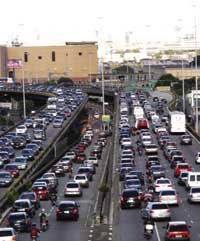
eduardo cesarBetter air quality, in spite of an increase by 60% in the vehicle fleeteduardo cesar
In spite of an increase of 60% in the vehicle fleet over the last 20 years, the levels of pollution by carbon monoxide, hydrocarbons and nitrogen dioxide in the Metropolitan Region of Sao Paulo has been reduced significantly. The improvement in air quality has come from the migration of industry and the expansion of the services sector. But it is also a result of the Air Pollution Control Program for Auto Vehicles (Proconve) that, since 1986, has established maximum limits on the emission of polluting fumes.
The new technologies incorporated by the car manufacturers has reduced the emission of pollutants by more than 90% for automobiles and by 80% for trucks. This was possible by way of changing the carburetors for injectors that electronically control the fuel feed, improving the combustion and consumption, as well as the implantation of emission control systems such as the catalytic converter.
These investments, as well as pushing forward the technological development of the auto industry, removed from the atmosphere particles that were responsible for the development of illnesses such as a heart attack, cerebral hemorrhage, bronchitis, asthma and pulmonary emphysema. The effects of the reduction of pollution upon the health of the population are impressive. The Experimental Atmospheric Pollution Laboratory (LPAE), of the Medical School of the University of São Paulo (USP), evaluated the impact of these measures upon the Metropolitan Region of São Paulo over the last ten years and concluded that 15,000 lives were saved, as confirmed by Paulo Saldiva, a researcher with the LPAE. The social costs of these deaths would have been US$ 1.5 billion.
The gain in health should be the main argument to justify investments in new technologies. “In order to build a hydroelectric power station environmental impact studies are demanded. The same thing doesn’t occur when the actions result in air pollution”, says Saldiva. São Paulo, he gave as an example, issues a license to 20,000 new vehicles per month. “Every three months these vehicles produce a volume of emissions equivalent to a gas thermoelectric station, which is highly polluting.”
New goals
The Proconve has completed 20 years with success, but now it has to establish new goals in order to attend to the new standards set by the World Health Organization (WHO). The WHO, the researcher exemplifies, is proposing a maximum limit of 20 micrometers (a millionth part of a meter) for fine inhalant particles coming from diesel emission. “São Paulo has particles with 40 micrometers”, he says. This difference, according to research done at the USP laboratory, results in nine deaths per day and has a social cost of US$ 300 million per year. In the case of the particles emitted by diesel engines, the greatest villains in the story are old buses and trucks – the fleet has an average age of 15 years – and they still circulate without using filters and adequate catalytic converters.
The solution lies in the obligatory inspection of vehicles, a measure adopted only in the atate of Rio de Janeiro. “The technology for this already exists”, underlines Saldiva.
Republish